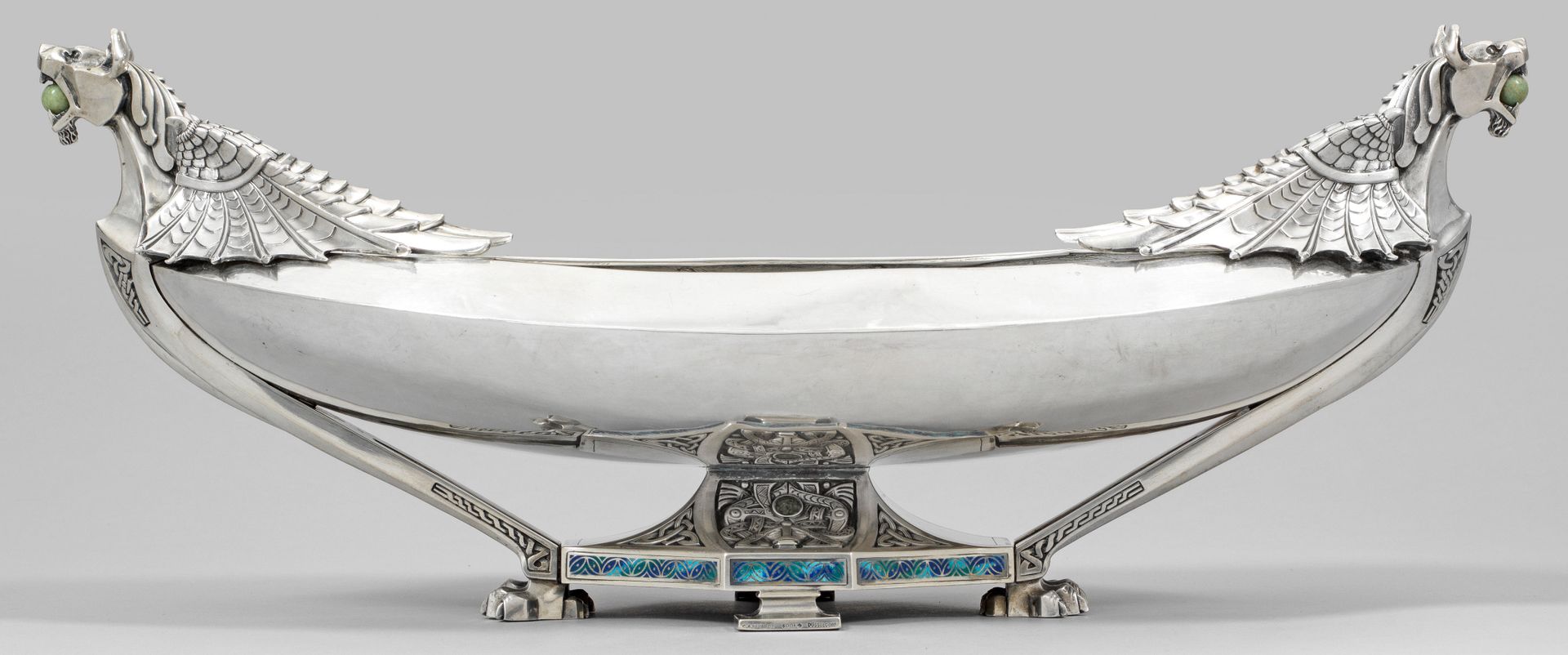Description
Exceptional neo-Gothic silver dragon bowl. Elongated, eight-cornered, conically ascending foot, supported by two small rectangular feet on the long sides and a pair of fully sculpted dragon feet on each of the short sides. Starting from this, two long outwardly extending struts as stylized dragon bodies, merging into laterally ascending handles in the form of heroic-looking dragon heads. Grasped by their angled wings, they hold an elliptical, smooth bowl in their center, reminiscent of a traditional Viking dragon boat. The wide open dragon mouths are each decorated with a greenish-beige, movable gemstone sphere. The stand and the side struts are decorated with Celtic knotwork, including the so-called Trinity Knot, stylized bull heads and intertwined ornamental bands, crowned with corresponding gemstone cabochons. The foot rim surrounded by a blue and turquoise enamel band. One ball minimally dam.; mark 800, maker's mark. Weight approx. 2030 g. H. 20 cm. 48.5 cm x 20 cm. Conrad Anton Beumers founded his jeweller's workshop in Düsseldorf in 1858 and specialized in particular in the production of sacred silver objects. The company was appointed purveyor to the royal imperial court in 1913. The Stadtmuseum Düsseldorf houses another bowl by the firm with "Nordic ornamentation", probably based on a design by Hugo Leven, cf. Krekel-Aalberse, Jugendstil und Art Déco Silber, p. 165, fig. 145; Scheffler, Rheinland-Westfalen, vol. I, no. 142. An extraordinary German neo-gothic silver dragon bowl with gemstones. One gemstone minor dented. Standard mark 800, maker's mark. German. Düsseldorf. Conrad Anton Beumers. Circa 1910.
583
Exceptional neo-Gothic silver dragon bowl. Elongated, eight-cornered, conically ascending foot, supported by two small rectangular feet on the long sides and a pair of fully sculpted dragon feet on each of the short sides. Starting from this, two long outwardly extending struts as stylized dragon bodies, merging into laterally ascending handles in the form of heroic-looking dragon heads. Grasped by their angled wings, they hold an elliptical, smooth bowl in their center, reminiscent of a traditional Viking dragon boat. The wide open dragon mouths are each decorated with a greenish-beige, movable gemstone sphere. The stand and the side struts are decorated with Celtic knotwork, including the so-called Trinity Knot, stylized bull heads and intertwined ornamental bands, crowned with corresponding gemstone cabochons. The foot rim surrounded by a blue and turquoise enamel band. One ball minimally dam.; mark 800, maker's mark. Weight approx. 2030 g. H. 20 cm. 48.5 cm x 20 cm. Conrad Anton Beumers founded his jeweller's workshop in Düsseldorf in 1858 and specialized in particular in the production of sacred silver objects. The company was appointed purveyor to the royal imperial court in 1913. The Stadtmuseum Düsseldorf houses another bowl by the firm with "Nordic ornamentation", probably based on a design by Hugo Leven, cf. Krekel-Aalberse, Jugendstil und Art Déco Silber, p. 165, fig. 145; Scheffler, Rheinland-Westfalen, vol. I, no. 142. An extraordinary German neo-gothic silver dragon bowl with gemstones. One gemstone minor dented. Standard mark 800, maker's mark. German. Düsseldorf. Conrad Anton Beumers. Circa 1910.
